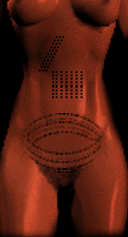
______________
Written records, physical remains, and works of art relevant to Egyptian tattoo have virtually been ignored by earlier Egyptologists influenced by prevailing social attitudes toward the medium. Today however, we know that there have been bodies recovered dating to as early XI Dynasty exhibiting the art form of tattoo. One of the more famous and written about mummies is that of Amunet, a priestess of the-goddess Hathor, at Thebes. This female mummy displayed several lines and dots tattooed about her body. ______________

A second mummy also found depicted this same type
of line pattern (the dancer). This
mummy also had a cicatrix pattern over her lower
pubic region. In the figure above you can see the various patterns as they
are displayed on the body. The various design patterns also appeared
on several figurines that date to the Middle Kingdom, these figurines
have been labeled the "Brides of Death." The figurines are
also associates with the goddess Hathor.
Another mummy found datable to about 2000 B.C. also displayed tattoos on her body resembling that of Amunet and the dancer. Robert Biachi states in his Tattoo in Ancient Egypt that: "Such tattoos created by grouping dots and/or dashes into abstract geometric patterns demonstrate the long duration of tattoo in ancient Nubia, as recent excavations at the Nubian site of Aksha demonstrate. Excavators at Aksha uncovered a number of mummies of both adolescent and adult women with blue (or black-blue) tattoos in precisely the same configurations as those found on the three Egyptian mummies from the Middle Kingdom.
These dot-and-dash patterns have been seen for many years throughout Egypt. Believed that this pattern and skill of tattoo was borrowed from the Nubians, the art of tattoo developed during the Middle Kingdom and flourished beyond. The evidence to date suggests that this art form was restricted to women only, and usually these women were associated with ritualistic practice. These mummies give us site into how long this art form has been practiced and how their art was displayed. From continent to continent this art form has developed and transformed. Through the Egyptian eyes to other cultures tattoo is something that satisfies various needs and interest.